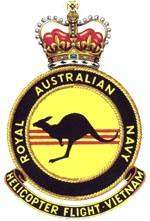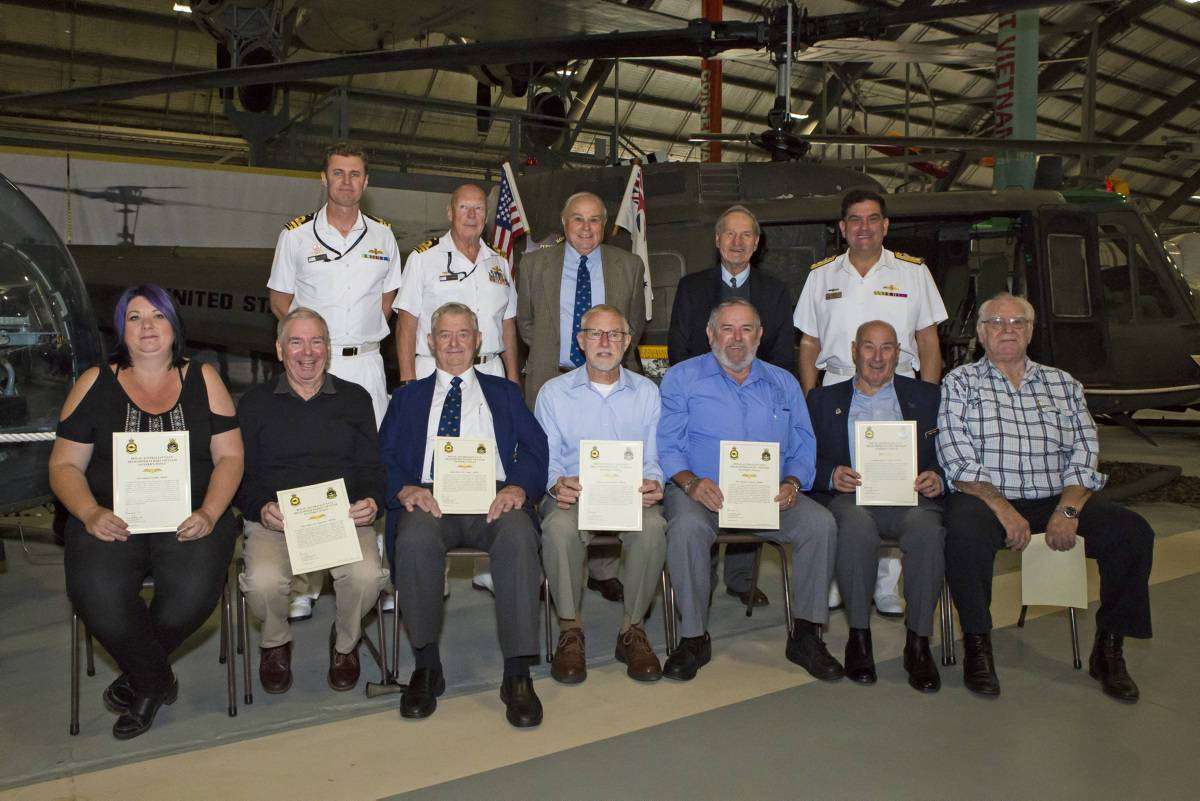 Between 1967 and 1971 about 200 naval air and ground crew served in four consecutive contingents of the Royal Australian Navy Helicopter Flight Vietnam (RANHFV) with the 135th US Army Assault Helicopter Company in the Experimental Military Unit (EMU). Of these 200 Australian servicemen there were 40 Royal Australian Navy and nine Australian Army (2 RAR) personnel who, although not part of their formal or primary duties, flew as door gunners in the UH 1 helicopters of the EMU on combat missions.
Between 1967 and 1971 about 200 naval air and ground crew served in four consecutive contingents of the Royal Australian Navy Helicopter Flight Vietnam (RANHFV) with the 135th US Army Assault Helicopter Company in the Experimental Military Unit (EMU). Of these 200 Australian servicemen there were 40 Royal Australian Navy and nine Australian Army (2 RAR) personnel who, although not part of their formal or primary duties, flew as door gunners in the UH 1 helicopters of the EMU on combat missions.
These were service personnel doing their duty during extraordinary times in extraordinary ways. Having been called upon to do their duty they met the challenge without formal or recognized training or category. As a result of this unconventional path, recognition of their service while on active duty and on return to Australia was not consistent. Some of those who flew as door gunners received recognition of their extraordinary duties as door gunners by the award of the United States Air Medal; others by the receipt of flying pay by the RAN; but most received no recognition. In order to address this lack of recognition many have proposed and sought to receive a talisman of their service – a unique badge or brevet – that they may wear to identify them as having served their nation in such a unique way.
Photo: Courtesy of John Peart shows an RANHFV door gunner’s platoon circa 1968 relaxing while a snapshot is taken. Pictured (L to R) Back row: Jim Hill seated; Baz Todd waving. Front row: (L to R) Terry Brooks; US Army-Sp5 Jerry Ables; PT Jones; Jeffery McIntyre and Tom Burton
Retrospective recognition for all those who flew as door gunners has been achieved by the award of a Helicopter Flight Vietnam Air Gunners’ Brevet and Certificate. The Brevet is based upon the RAN Aviators “Wings” within which is depicted crossed general purpose machine guns and the date 1967-1971. Each Brevet is numbered on the back and identified as having been presented to an individual. The presentation included an appropriately worded Certificate, an example of which can be seen here. Presentations of the Brevet and Certificate were mainly conducted in Sydney, Brisbane and Perth in the week commencing 22 March 2016. Photographs of some of the awards can be seen below and a full list of recipients can be found here.
Above: Recipients of the Air Gunners Wings and representatives with current serving members of the Fleet Air Arm section of the Royal Australian Navy, at the Fleet Air Arm Museum, Nowra. Front row, left to right: Ms M. Thorpe (daughter of the late AB N.J. Hill Ret’d); PO J.R.Macartney Ret’d; PO K.W. Camm Ret’d; AB F.A. Eyck Ret’d; AB J.J. Martin Ret’d; LS P. Vidler Ret’d AB I. Waskiw Ret’d.
Above: Three Royal Australian Navy members (retd) are awarded “wings” by Commander Fleet Air Arm, Commodore Vince Di Pietro, CSC, RAN, for their service as “Window Gunners” during the Vietnam War at a ceremony held at HMAS Penguin. Recipients are, left to right: AB K. Wardle Ret’d; AB J. Peart Ret’d and PO P. Jones Ret’d.
Six Vietnam Veterans from the Royal Australian Navy and the Australian Army after they were awarded Certificates of Service and Gunner’s Wings in the Officers and Sergeants Mess at Leeuwin Barracks. Left to right: Winston James; Alan Wichcombe; Ralph Hoger; Ted Wynberg (at back); Keith Taylor; CDRE Vince Di Pietro; Andy Curran; Brett Dowsing (at back); Doug Rasmussen; Bary Todd and the late Clive Mayo.
Victorian recipients of the Helicopter Flight Vietnam Wings and presenters after their presentation ceremony held at Recruit School of HMAS Cerberus, Victoria.Left to right:Commanding Officer Recruit School, Commander Luke Ryan, RAN; Able Seaman Retired Ian Wilson; Private Retired Bob Devers; Private Retired Robert Carmichael; Able Seaman Retired Jeffery Moore; Private Retired Stan Jaruga; Leading Seaman Retired Wayne Sissing; Private Retired Bill Wearne; Commander Max Speedy, RAN, Rtd.
T.Wynberg; T.Domanski; M.Blackman; B.Goener; F.Lord; A.Whiteman; G.Hurford; B.Fisher; V.DiPietro
For award to Private Kerry Pearce (deceased) click here.
Profile of a Door Gunner’s Duty
(Courtesy Kim Dunstan)
From September 1967 until June 1971 the Royal Australian Navy Helicopter Flight (RANHFV) was fully integrated into the US Army 135th Assault Helicopter Company flying ‘Huey’ Iroquois helicopters in combat missions. They operated the UH-1H ‘Slick’ troop carriers and the UH-1C ‘Gunship.’ Both types carried a crew of four comprising two pilots and two door gunners who were seated either side of the transmission firewall in the rear cabin
On the UH-1H ‘Slick’ door gunners would operate their M60D machine gun mounted on a pintle post with a traversing lock to prevent the arc of fire striking the helicopter they were in. They would provide covering fire prior to landing and while troop were inserted or extracted at a LZ. Exceptional door gunners on the ‘Slick’ helicopters would graduate to UH-1C ‘Gunships’, but they had to be volunteers as ‘Gunships’ were most likely to attract enemy fire as they flew around the landing zone suppressing enemy fire prior to the approach of the ‘Slicks’ to a landing zone (LZ).
An attacking ‘Gunship’ would dive towards the target with the pilot firing the 2.75 inch rockets down to about 500 metres thus avoiding flying into shrapnel from the exploding rockets. Some ‘Gunships’ also had a 40mm grenade launcher. The co-pilot would fire the two externally mounted, six-barrel 7.62 mm mini-guns, aimed via a flexible sight which moved the guns up or down or to the left or right. Firing would continue down to about 300 metres.
At the end of a strafing run the height of a gunship would be around 30 metres or below and well with in small arms range – typically Soviet or Chinese made weapons such as the Kalashnikov AK-47 assault rifle, the SKS carbine or DP28 LMG all of which were very effective against thin skinned helicopters. Heavier weapons like the 12.7mm machine gun and RPGs were especially deadly.
At this point the ‘Gunship’ pilot would break-off the attack and bank left or right exposing the underside of the helicopter. Door gunners would generally stand on the skids outside the helicopter with their M60 on a bungee cord and fire to the front, under the aircraft and to the rear as the ‘Gunship’ moved away from the firing zone.








